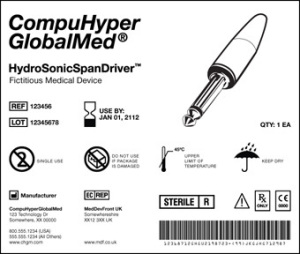FDA releases proposed UDI rules
by
Brendon Nafziger, DOTmed News Associate Editor | July 03, 2012

Sample UDI label (Credit: FDA)
The Food and Drug Administration has released proposed rules for a medical device tracking system its backers claim can make it easier to find recalled devices and also to identify what specific products are causing problems.
On Tuesday, the FDA released the unique device identifier, or UDI, rule. The release comes several months ahead of the December 31 deadline it would have been given by Congress because of a provision in the recently passed FDA user fee renewal bill, which is expected to be signed by President Obama soon.
The release of the rules brings to a close a nearly five-year wait by the health care industry for the device-tracking regulations. The FDA was first tasked with publishing UDI rules by Congress in a 2007 law. While the FDA did release its original proposed rules in July 2011, the regulations were then held up by the Office of Management and Budget, for reasons that have never been made clear.
What it does
The agency hopes the UDI can help providers better identify devices that cause adverse events and then find them to remove them from the market. According to the FDA, from 2005 to 2009, it received reports of nearly half a million adverse events involving devices each year. However, many of the problem devices were hard to identify at first because of the different product ID formats used in the reports, according to the FDA.
"Although we do not have precise statistics, many initial reports do not provide a precise identification of the specific device the report concerns and require extensive FDA follow-up to identify the specific device involved," the agency said.
The proposed solution, the UDI, comes in two parts: a number or letters-and-number combo that refers to the device model, and a product identifier that contains serial, lot or batch number, and the expiration date. This information would appear on a device or its packaging in both plain text, readable by a person, and in a machine-readable form, such as a bar code.
But the expected benefits of the UDI mostly come from an in-the-works public online database, which the UDI would direct providers to. This would contain potentially clinically important information about the device. The database, once up, would be available to providers, suppliers and the general public, the FDA said.
"The real value of a UDI is derived from its connection to corresponding information identifying the version or model of the device that bears the UDI, and an effective system of device identification requires both a UDI and a database to provide information concerning the particular version or model identified by that UDI," the agency explained.
|
|
|
You Must Be Logged In To Post A Comment
|

John Weymouth
This is a good thing and it will cost money in the short term.
July 05, 2012 12:49
It will cost manufacturers money to redo the labels. The benefit to the industry, patients and reducing the cost of investigations is the real plus. It should take 2 months for the redesign, approval and implementation of the labels. An additional label that would reduce the redesign time-frame may be an option. Reused items may be the bigger problem with injection molds. Metal devices could be acid etched or yag laser marked. Manufactures need to get started or if they were on top if issues, they have had 5 years to think of options.
john@medisurg.com
to rate and post a comment